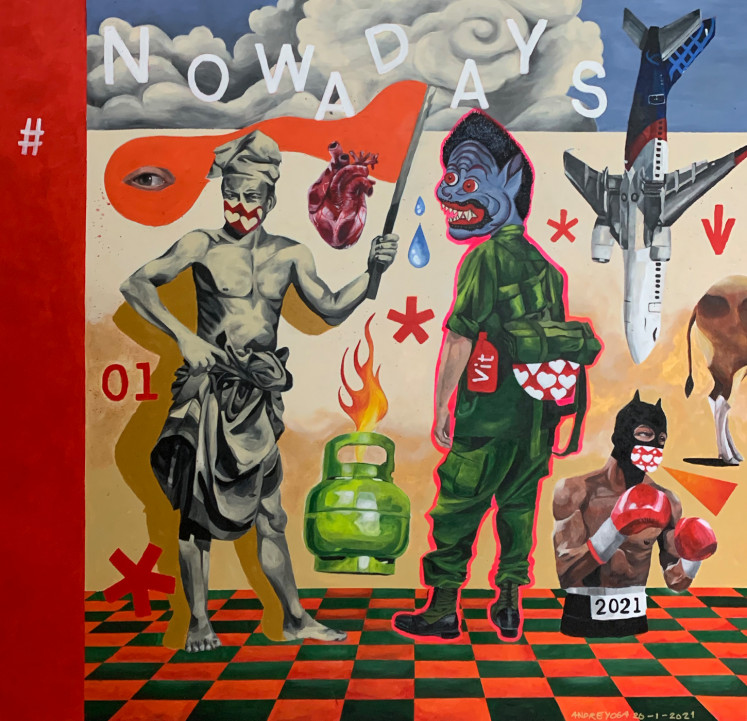Popular Reads
Top Results
Can't find what you're looking for?
View all search resultsPopular Reads
Top Results
Can't find what you're looking for?
View all search resultsVirtual art galleries: Bringing artists closer to their audience
The digital world is now peppered with virtual galleries which aim to bridge art collectors from around the globe, without losing the essence of personal presentation
Change text size
Gift Premium Articles
to Anyone
T
he digital world is now peppered with virtual galleries that aim to bridge art collectors from around the globe without losing the essence of personal presentation.
The digitalization of the art industry was bound to happen. Purists might disagree, but the ways people interact with works of art are now being transformed by the ubiquity of internet platforms. With the pandemic leading to a so-called new normal, galleries around the world are turning to virtual exhibitions.
Adapting to the changes, Adella Bahar, 26, and Brina Paska, 26 established Cakravala, a digital-based gallery in Indonesia.
“When the pandemic started here last year, I was still finishing my degree in art curating in Sydney [Australia]. In my degree, a lot of people do not appreciate virtual art galleries. But I thought under these circumstances, we need to quickly adapt to the situation,” said Adella.
Adella wanted to focus on content that would bridge artists and art collectors.
“There was a massive gap between appreciating art in a physical space [...] and browsing or scrolling through galleries online.”
To keep their audience engaged, Adella and Brina created digital content such as an artist-to-artist talk and workshops. On Cakravala, art enthusiasts can browse their favorite artists’ profiles. It also allows artists to communicate the meaning of their artwork to their audience. In addition to that, there is a dedicated section in the platform called Inside the Mind Of where artists talk about their projects.
“We want to make sure that our content is as engaging as possible. We also encourage our audience to have a conversation,” Adella explained.
“Because we’re an online gallery, the collector doesn't need to meet the artist face-to-face. Instead, they can browse all the content they want to see,” Brina added.
“The importance of my degree is making art accessible to everyone, breaking that level of exclusivity and making art more inclusive are the concepts of the virtual gallery,”
Adella told The Jakarta Post: “Instead of dwelling within the boundary of a gallery model, we try to enhance the experience by using the digital space."
Adella also hopes that her gallery will also create a more transparent art market.
“Whenever I want to see the artwork or the price of the piece, I would go to the artists’ website or profile, just like any art buyer. The process of acquiring artwork itself is exclusive.”
Technological advantages
For the last few months, other digital galleries have emerged throughout the internet, including Where’s the Frame? Gianina Ivodie and Maribelle Bierens, the cofounders of Where’s the Frame? said digital galleries had created a new space for both artists and collectors. Similar to Cakravala, Where’s the Frame? was born during the pandemic. The team also offers concierge services to collectors and operates between Indonesia and the United Kingdom.
To adapt to the new changes, Gianina and her team used Kunstmatrix to create a 3D-like exhibition that could be viewed from the user’s gadgets. She did not expect many collectors to enjoy the digital gallery settings.
“From the feedback we heard, it helps the collectors view the artwork in a gallery setting, with the correct scale of the works placed on a wall. It makes the collecting experience even more real and pleasurable.”
She also realized that Millennials and Gen-Zers tend to consume and learn about art in a quick and practical manner. So, an online exhibition or presenting your work online is a great way to reach a lot of people, she said.
She further explained that the digital gallery has helped different parts of the world.
“Widespread accessibility is one of the big advantages of operating online. The artwork we sell, interviews we conduct and articles we write reach a lot of people around the world. That might have been different if we had employed a more traditional brick-and-mortar kind of gallery that is primarily accessible to locals or tourists,” she said.
Andre (center) is an artist who has been using digital platforms to showcase his work. (Courtesy of Andre Yoga). (Personal archive/Courtesy of Andre Yoga)Gianina herself is working together with artists around the world, including Indonesia, the United States, the UK and many more.
Gianina and Maribelle create a lot of content for each artist through personal videos, write a research-based text about their practice and put it in an art-historical perspective. The content is something that is not used in the traditional gallery.
But by far, technology has enabled Where’s the Frame? to be connected and create a new platform for younger collectors and traditional art collectors.
“Using email, direct message, Zoom, Microsoft Teams or online contact forms, we’ve been able to connect to different creatives from all over the world. We’ve set up partnerships with artists from almost every continent without ever meeting them by just talking to them through these different channels.”
Creating more space for emerging artist
The existence of art galleries during the pandemic also has an important role for young artists. Cakravala is focusing on the emerging artists of Indonesia.
“We enjoy artworks or artists that have a distinct style, with an Indonesian twist. It could be about Indonesia's heritage or locally nuanced themes. Additionally, we are also interested in knowing who is influencing the artists,” Adella and Brina explained.
Adella and Brina also said that currently, they were still trying to introduce local art to the younger generation. As most of the art inspired by the Indonesian culture has deep stories, the two curators realize that many young people now prefer to see something "light".
“Digital galleries are really important for millennials because right now, everyone is living on their screen. Ironically, we are both far and close to each other at the same time because of the internet. It can be a platform or the catalyst that brings people together," Adella said.
"Nowadays" by Andre Yoga was inspired by the events of recent years. (Courtesy of Andre Yoga). (Personal archive/Courtesy of Andre Yoga)One of the artists who exhibited his work with Cakravala is I Kadek Agus Andre Yoga Permana, 27. Having showcased his artwork, including Nowadays (2021), Identity (2021) and Revolution (2021), Andre could not deny that a digital art space is completely different from a traditional gallery.
"A lot has changed. I recently had to make a presentation about my latest work. I realized that making art does not stop with finishing the work itself, but also involves presenting it to the audience,” Andre said.
Andre further explained that virtual exhibitions have limitations.
“Interaction with collectors is quite difficult. Our interaction has to be through chat. Sometimes I offer them a studio visit too," Andre continued.
Many of Andre's artwork is inspired by the industrial revolution in Indonesia, such as Revolution. In this work, Andre reflects on the impacts of a speedy global culture of life in Indonesia, where most people choose to relax over working hard. Andre shows the contradictions of two worlds through the imagery of a man relaxing on his buffalo while still being controlled by satellites.
I Wayan Kastina, 44, an art collector based in Bali, has been enjoying the presence of the digital gallery.
“Now it's easier to follow the progress of an artist through digital galleries. In the past, we had to attend an exhibition physically, wherever it might be. Now, there is this digital gallery where we can follow the artists or works conveniently. Additionally, the audience will not have the access to see works of art that have been purchased. Online galleries allow you to see previous works and the stories of the piece."
Furthermore, as a collector, I Wayan has no problem with digital galleries as he has also enjoyed auctions from digital galleries. He said information about artists and their work is now much easier to find on the internet.
“We are exploring the possibility of working online as a great alternative or addition, but we do not envision this to become the norm,” Gianina said.













